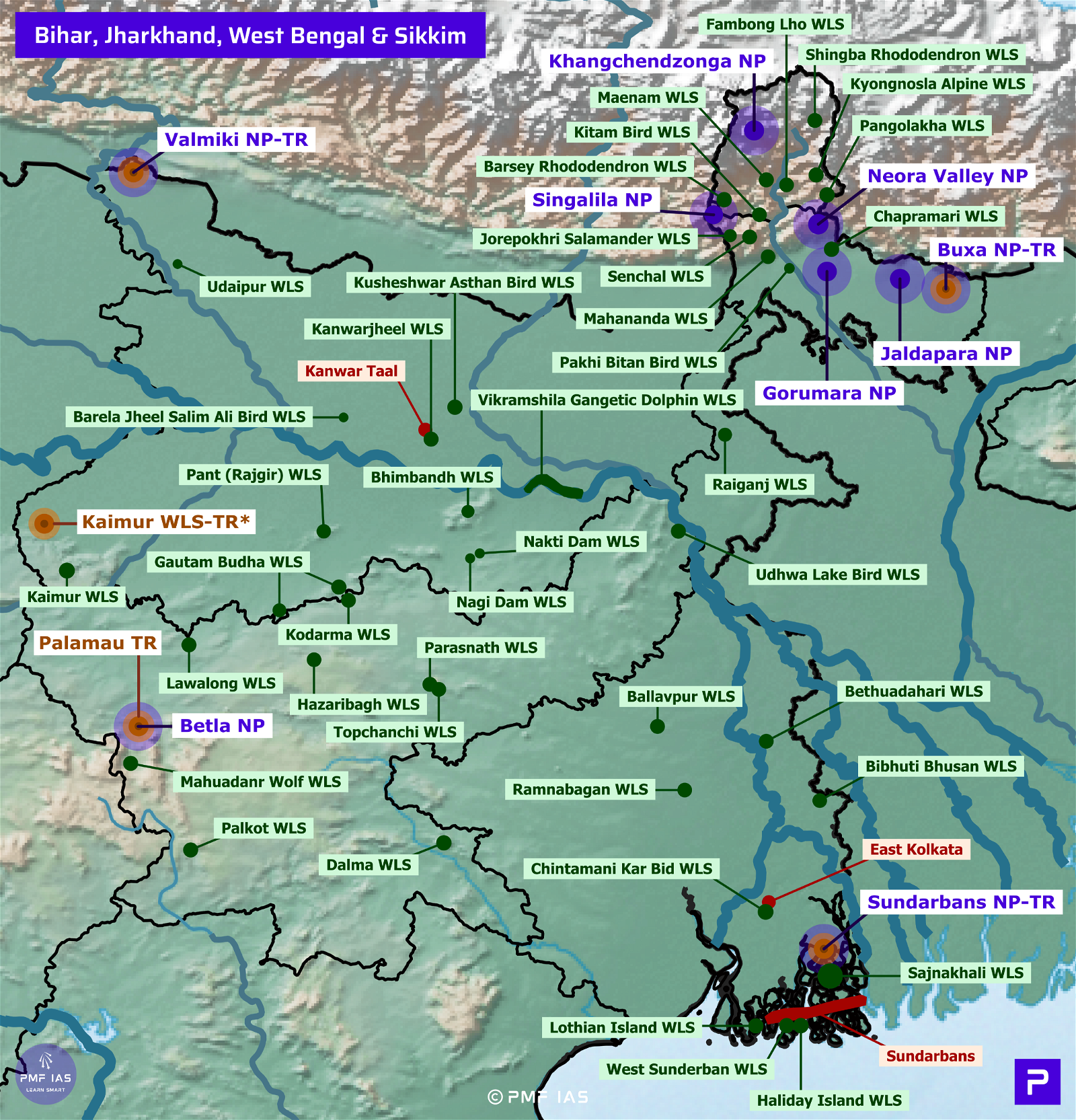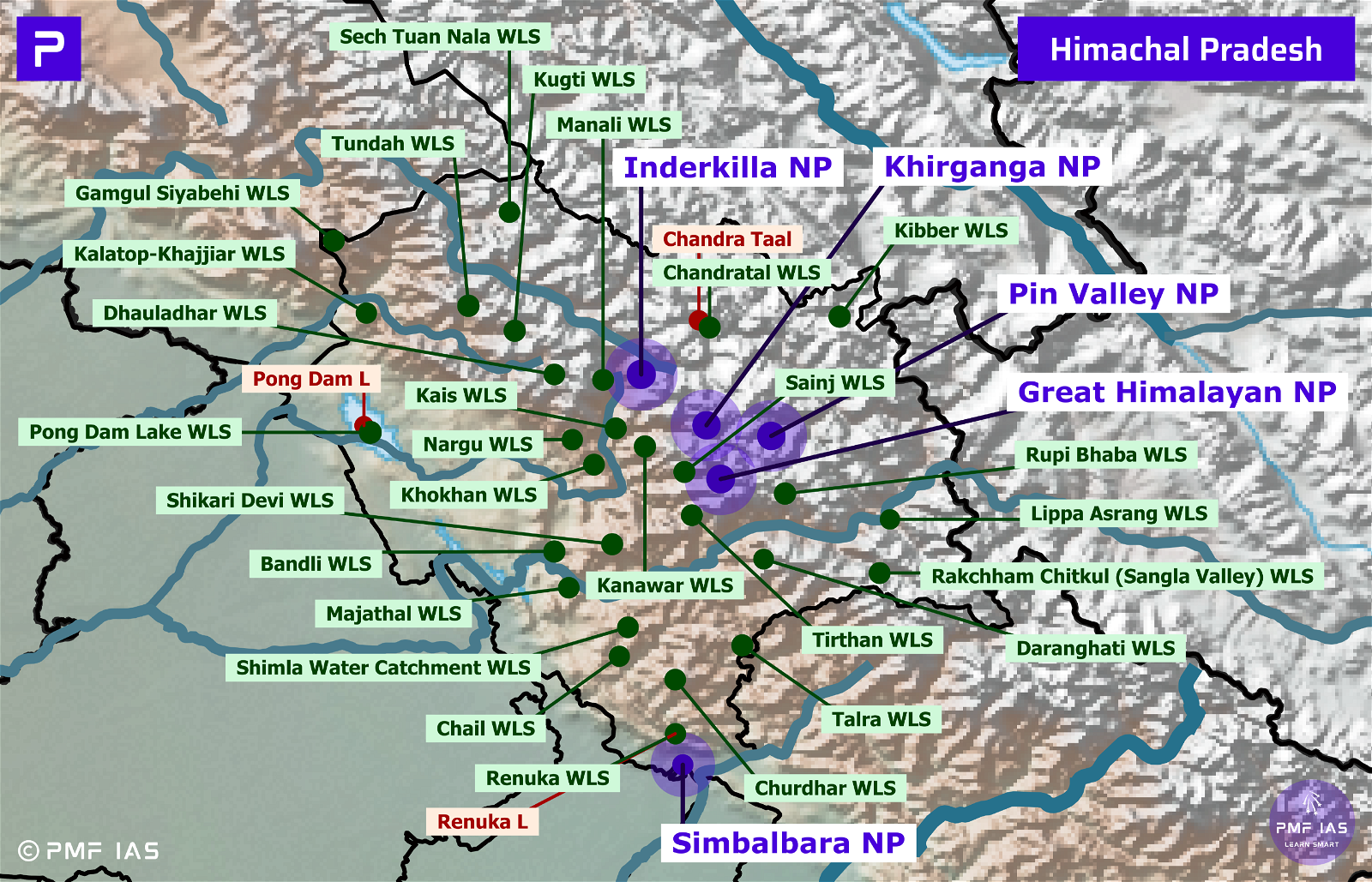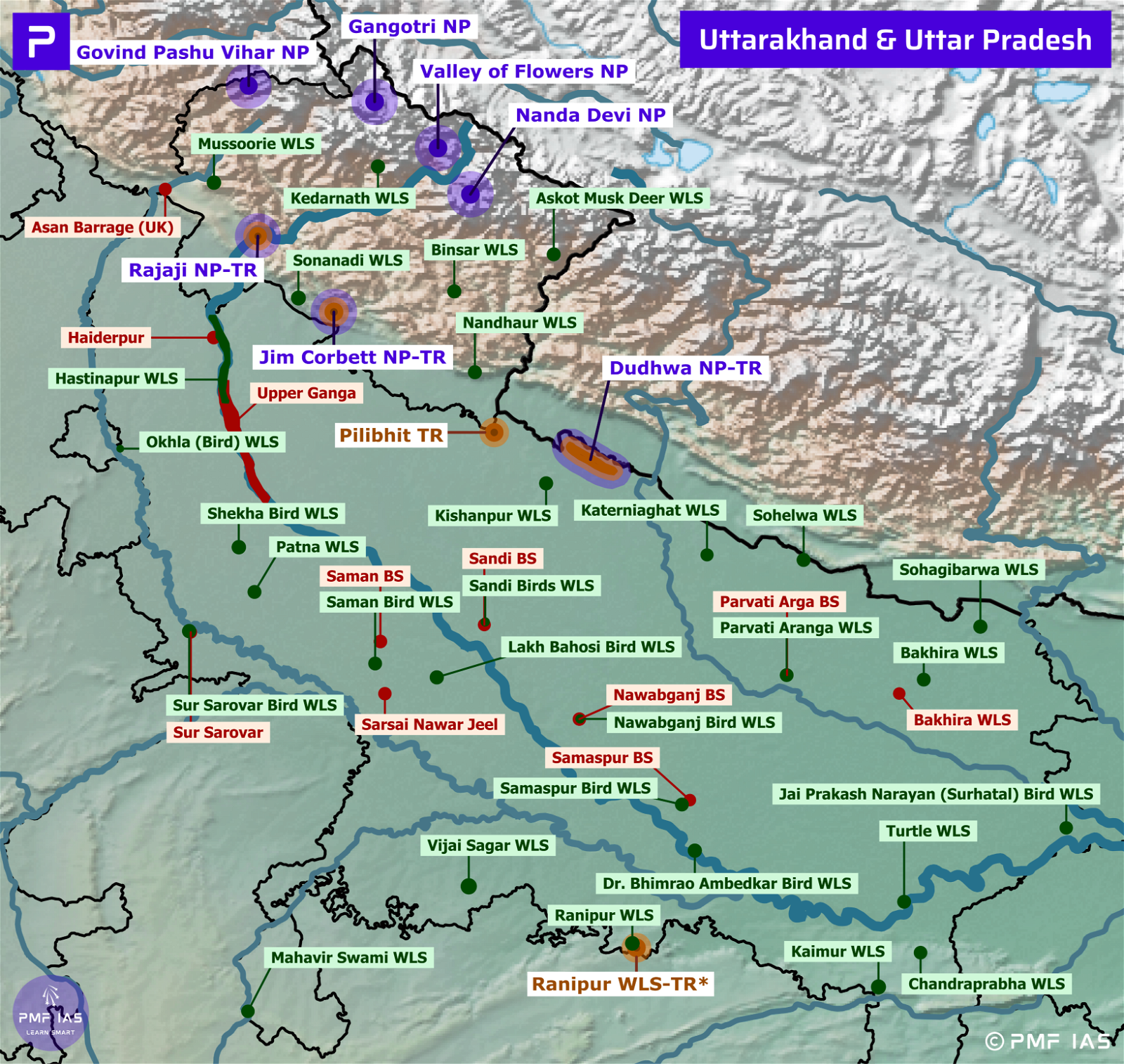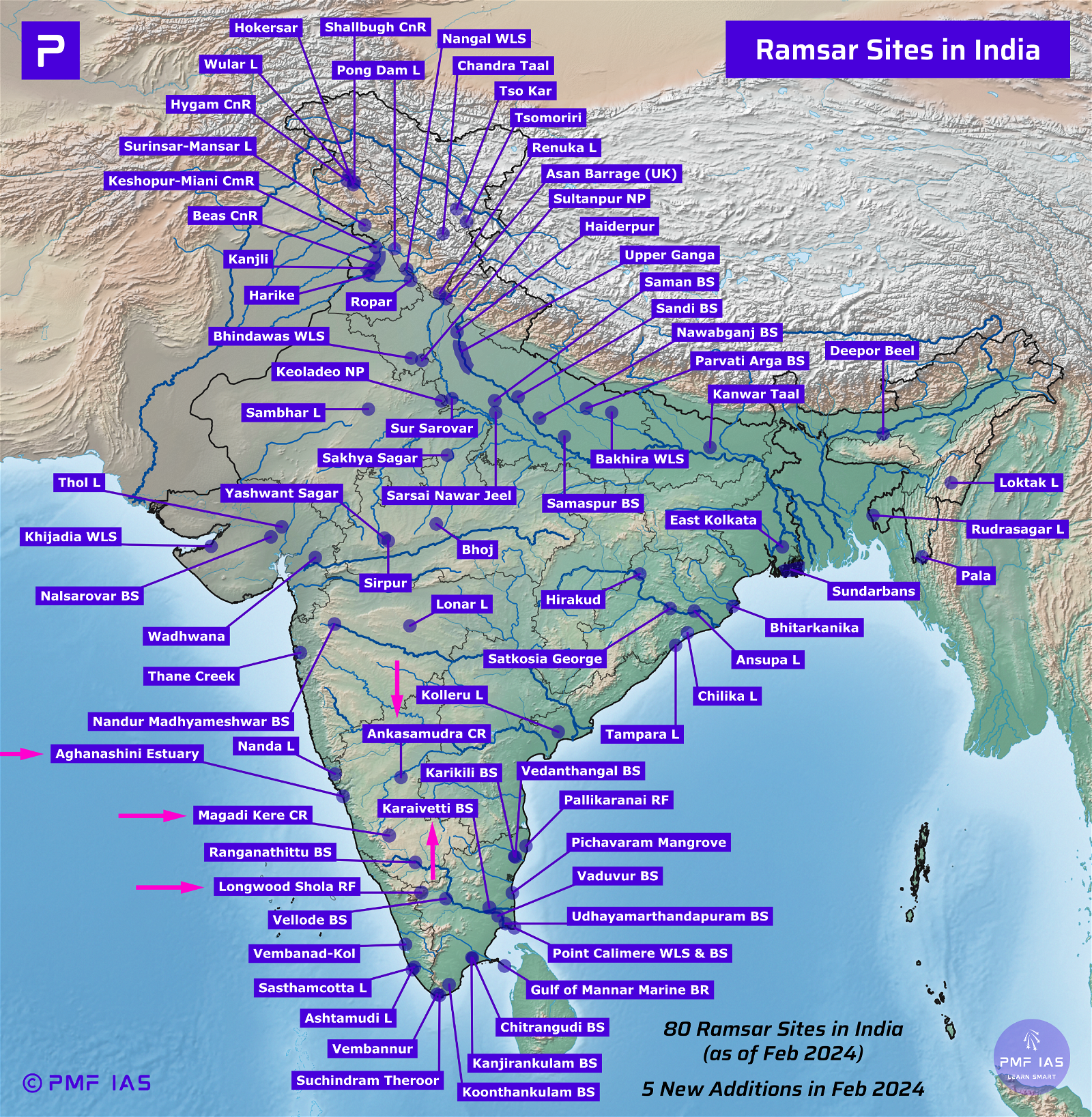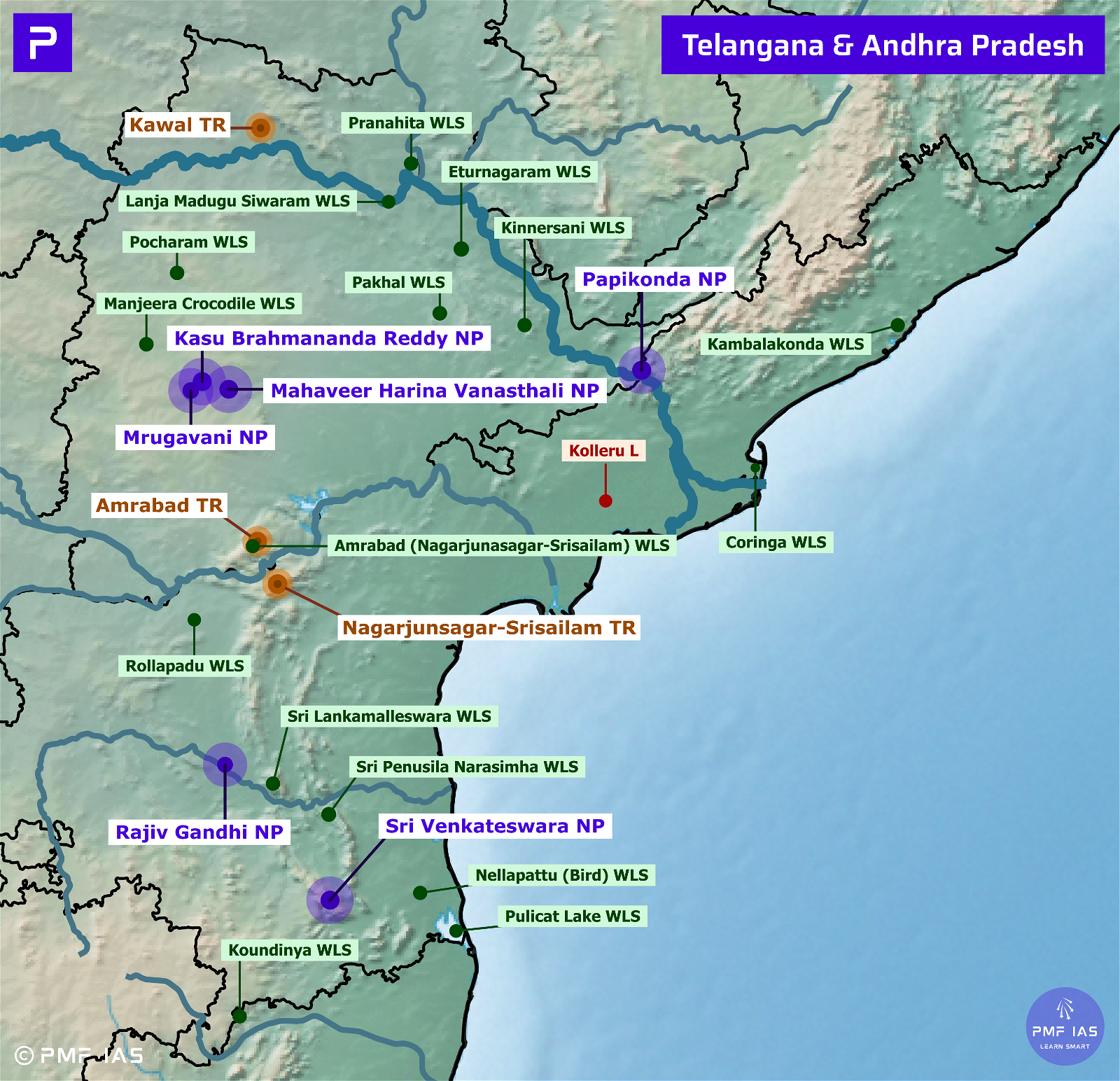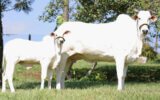
Biosphere Reserves of India (18 Biosphere Reserves in India (12 Recognized by UNESCO’s MAB))
Subscribe to Never Miss an Important Update! Assured Discounts on New Products!
Must Join PMF IAS Telegram Channel & PMF IAS History Telegram Channel
Biosphere Reserve
- Biosphere reserves are sites established by countries and recognized under UNESCO’s Man and the Biosphere (MAB) Programme to promote sustainable development based on local community efforts and sound science.
- The World Network of Biosphere Reserves currently consists of 738 sites in 134 countries, including 22 transboundary sites.
Biosphere Reserves of India
- Presently, there are 18 notified biosphere reserves in India (12 recognized by UNESCO’s MAB).
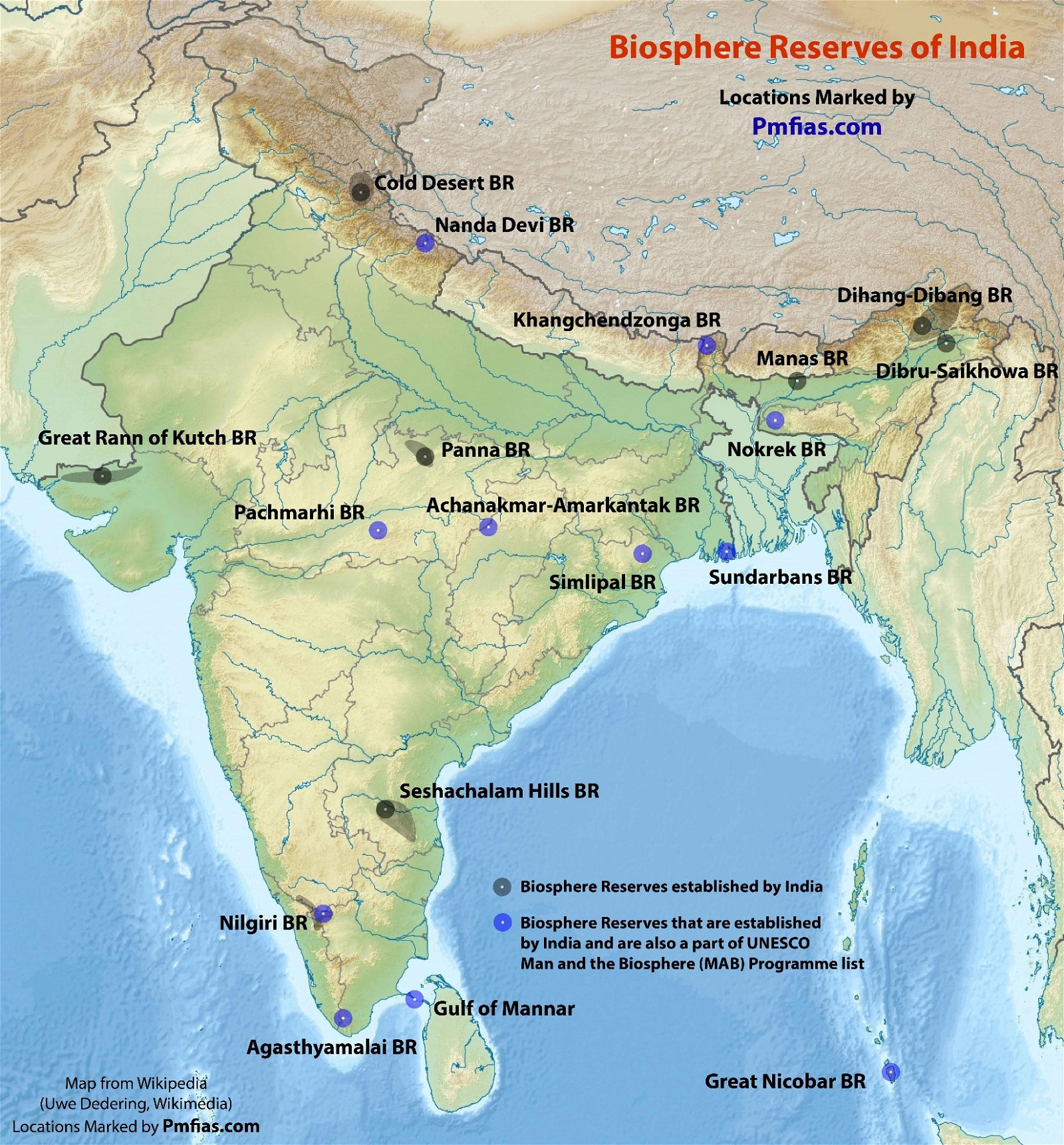
|
S.No. |
Year |
Name |
State |
Area (km2) |
| 1 | 1986 |
Nilgiri Biosphere Reserve |
TN (2537), Kerala (1455), Karnataka (1527) |
5520 |
| 2 | 1988 |
Nanda Devi Biosphere Reserve |
Uttarakhand |
5860 |
| 4 | 1988 |
Nokrek Biosphere Reserve |
Meghalaya |
820 |
| 3 | 1989 |
Gulf of Mannar Biosphere Reserve |
Tamil Nadu |
10500 |
| 5 | 1989 |
Sundarbans Biosphere Reserve |
West Bengal |
9630 |
| 6 | 1989 |
Manas Biosphere Reserve |
Assam |
2837 |
| 7 | 1989 |
Great Nicobar Biosphere Reserve |
Andaman and Nicobar Islands |
885 |
| 8 | 1994 |
Simlipal Biosphere Reserve |
Odisha |
4374 |
| 9 | 1997 |
Dibru-Saikhowa Biosphere Reserve |
Assam |
765 |
| 10 | 1998 |
Dihang-Dibang Biosphere Reserve |
Arunachal Pradesh |
5112 |
| 11 | 1999 |
Pachmarhi Biosphere Reserve |
Madhya Pradesh |
4982 |
| 12 | 2000 |
Khangchendzonga Biosphere Reserve |
Sikkim |
2620 |
| 13 | 2001 |
Agasthyamalai Biosphere Reserve |
Kerala, Tamil Nadu |
3500 |
| 14 | 2005 |
Achanakmar-Amarkantak BR |
Madhya Pradesh, Chhattisgarh |
3835 |
| 15 | 2008 |
Great Rann of Kutch BR |
Gujarat |
12454 |
| 16 | 2009 |
Cold Desert Biosphere Reserve |
Himachal Pradesh |
7770 |
| 17 | 2010 |
Seshachalam Hills Biosphere Reserve |
Andhra Pradesh |
4755 |
| 18 | 2011 | Madhya Pradesh |
543 |
|
|
Biosphere Reserves Established by India | Biosphere Reservs Established by India and Recognized by UNESCO’s MAB |
||||
Nilgiri Biosphere Reserve
- Nilgiris (blue mountain) got their name from the purplish blue flowers of Neelakurinji (blossoms once in 12 years).
- The Nilgiri Sub-Cluster (UNESCO World Heritage Site) includes the Mudumalai, Mukurthi, Nagarhole, Bandipur and Silent Valley national parks, as well as the Aralam, Wayanad and Sathyamangalam wildlife sanctuaries.
- Vegetation: tropical evergreen forests (western side of Western Ghats), montane sholas and grasslands (at high altitudes), semi-evergreen forests, moist deciduous forests, dry deciduous forests, and thorn forests.
- Major Fauna: Lion Tailed Macaque (EN), Nilgiri Tahr (EN), Malabar Giant Squirrel (LC), Nilgiri Langur (VU), etc.
Nanda Devi Biosphere Reserve
- Nanda Devi Biosphere Reserve = Nanda Devi National Park + Valley of Flowers NP.
- Major Fauna: Snow Leopard (VU), Musk Deer (EN), Bharal Or Blue Sheep (LC), etc.
Nokrek Biosphere Reserve
- Nokrek (1,412 m) is the highest peak of the Garo hills.
- Vegetation: Evergreen, semi-evergreen & deciduous.
- Key Fauna: Red Panda (EN), Hoolock Gibbons (EN), Red Giant Flying Squirrel (LC), etc.
Gulf of Mannar Biosphere Reserve
- It lies between the west coast of Sri Lanka and the south-eastern tip of India, in the Coromandel Coast region.
- The chain of low islands and reefs known as Ramsethu (Adam’s Bridge), which includes Mannar Island, separates the Gulf of Mannar from Palk Bay, which lies to the north between Sri Lanka and India.
- The biosphere reserve comprises islands with estuaries, seagrasses, coral reefs, salt marshes and mangroves.
- Major Fauna: Dugong (VU), Olive Ridley turtles (VU), etc.
Sundarbans Biosphere Reserve
- It is located in the vast Delta of the Ganges, south of Kolkata and bordering Bangladesh in the east. It provides habitat for the threatened Royal Bengal Tiger (EN).
- Sundarbans BR = Sundarbans National Park + Sajnekhali Wildlife Sanctuary + Lothian Wildlife Sanctuary + Haliday WLS.
Manas Biosphere Reserve
- Manas BR = Manas National Park. It is contiguous with the Royal Manas National Park in Bhutan. Manas is famous for its population of the Wild Water Buffalo (EN).
- Rare and endemic wildlife: Assam Roofed Turtle (EN), Hispid Hare (EN), Golden Langur (EN) & Pygmy Hog (EN).
- The grassland biomes: Pygmy Hog, Rhinoceros (re-introduced in 2007), elephants, Bengal florican (CR) etc.
Great Nicobar Biosphere Reserve
- Great Nicobar BR = Campbell Bay National Park + Galathea NP.
- Vegetation: tropical wet evergreen forests.
- Major Fauna: Dugong (VU), Saltwater Crocodile (LC), etc.
Similipal Biosphere Reserve
- It includes Mayurbhanj Elephant Reserve (Similipal TR + Hadgarh Wildlife Sanctuary + Kuldiha WLS).
- Tribes: Erenga, Kharias, Mankirdias, Ho, Gonda & Munda.
- Major Fauna: Royal Bengal Tigers, Wild Elephants (EN), Gaurs (VU – Indian Bison), Chausingha (VU).
Pachmarhi Biosphere Reserve
- Pachmarhi BR (Satpura National Park + Bori Wildlife Sanctuary + Pachmarhi WLS) lies in the centre of the Satpura Range. The highest peak is the Dhoopgarh (1,352 m). Gonds are the major tribes.
- Fauna: Tiger, Gaur, Indian Giant Flying Squirrels (LC), etc.
Khangchendzonga Biosphere Reserve
- The biosphere reserve is a transboundary bio-diversity hotspot conservation area. It includes the third highest mountain peak in the world, Kanchenjunga (8,586 m). It is one of the highest ecosystems in the world, reaching elevations of 1,220 m to 8,586 m above sea level.
- The Khangchendzonga NP, which comprises the core area of the KBR, was inscribed as India’s first “Mixed World Heritage Site”.
- Major Fauna: Red Panda (EN), Snow Leopard (VU), Musk Deer (EN), Great Tibetan Sheep (Argali – NT), etc.
Dibru-Saikhowa Biosphere Reserve
- Dibru-Saikhowa BR = Dibru-Saikhowa National Park.
- Major Fauna: Bengal Tiger, Clouded Leopard (VU), Gangetic Dolphin (EN), etc.
Dihang-Dibang Biosphere Reserve
- The Mouling NP and the Dibang WLS are located fully or partly within this biosphere reserve. The terrain is rugged, with an altitudinal range of 750 to 3000 m at the highest point, the Mouling Peak.
- Major Fauna: Takin (VU), Red Panda (EN).
Agasthyamala Biosphere Reserve
- Agasthyamala BR = Shendurney Wildlife Sanctuary + Peppara Wildlife Sanctuary + Neyyar Wildlife Sanctuary + Kalakad Mundanthurai TR. The reserve is home to Kani tribes from both Tamil Nadu and Kerala.
- Major Fauna: Nilgiri Tahr (EN)
Q. Which one of the following are Agasthyamala biosphere reserve?
|
Achanakmar-Amarkantak Biosphere Reserve
- It extends across the states of Madhya Pradesh and Chhattisgarh. Maikal hills together with eastern Vindhyas and Satpuras lie within the reserve.
- Major Fauna: Four Horned Antelope (Chausingha (VU)), Indian Wild Dog (VU), etc.
- Vegetation: moist deciduous and dry deciduous forests.
Great Rann of Kutch Biosphere Reserve
- The Great Rann of Kutch is a salt marsh in the Thar Desert.
- Great Rann of Kutch BR = Kachchh Desert Sanctuary (in Great Rann of Kutch) + Wild Ass Sanctuary (in Little Rann of Kutch), Narayan Sarovar Sanctuary + Kutch Bustard Sanctuary + Banni Grasslands Reserve.
- Major Fauna: Great Indian Bustard (CR), Indian Wild Ass (NT), etc.
Cold Desert Biosphere Reserve
- It includes Pin Valley National Park, Chandratal, Sarchu and Kibber Wildlife Sanctuaries.
- Major Fauna: Snow Leopard (VU), Himalayan Ibex (also referred to as Siberian Ibex – LC).
Seshachalam Hills Biosphere Reserve
- The Seshachalam Hills are part of the Eastern Ghats (south of Panna River) in southern Andhra Pradesh.
- Tirupati, a major Hindu pilgrimage town and Srivenkateshwara National Park are located in these ranges.
- Major Flora: rare and endemic plant species like Red Sanders (NT) are of great economic importance.
- Major Reptilian Fauna: Golden Gecko (LC – Endemic To Tirumala Hills).
Panna Biosphere Reserve
Salient Flora/Fauna of the Biosphere Reserves of India
| Name | Key fauna |
|
Nilgiri BR |
Lion Tailed Macaque (EN), Nilgiri Tahr (EN), Malabar Giant Squirrel (LC), Nilgiri Langur (VU) |
|
Nanda Devi BR |
Snow Leopard (VU), Musk Deer (EN), Bharal Or Blue Sheep (LC) |
|
Gulf of Mannar |
|
|
Nokrek |
Red Panda (EN), Hoolock Gibbons (EN), Red Giant Flying Squirrel (LC) |
|
Sundarbans |
Royal Bengal Tiger (EN) |
|
Manas |
Assam Roofed Turtle (EN), Hispid Hare (EN), Golden Langur (EN), Pygmy Hog (EN), Wild Water Buffalo (EN), Bengal florican (CR) |
|
Simlipal |
Royal Bengal Tigers, Wild Elephants (EN), Gaurs (VU – Indian Bison), Chausingha (VU) |
|
Dihang-Dibang |
|
|
Pachmarhi BR |
Tiger, Gaur, Indian Giant Flying Squirrels (LC) |
|
Achanakmar-Amarkantak BR |
Four Horned Antelope (Chausingha (VU)), Indian Wild Dog (VU) |
|
Great Rann of Kutch |
|
|
Cold Desert |
Snow Leopard (VU), Himalayan Ibex (also referred to as Siberian Ibex – LC) |
|
Khangchendzonga |
Red Panda (EN), Snow Leopard (VU), Musk Deer (EN), Great Tibetan Sheep (Argali – NT) |
|
Agasthyamalai BR |
Nilgiri Tahr (EN) |
|
Great Nicobar BR |
|
|
Dibru-Saikhowa |
|
|
Seshachalam Hills |
Red Sanders (NT), Golden Gecko (LC – Endemic To Tirumala Hills) |
|
Panna |
Natural World Heritage Sites in India
|
Name of WH Site |
Location |
Notified in |
Area (km2) |
|
| 1 |
Great Himalayan National Park Conservation Area |
Himachal Pradesh | 2014 |
905 |
| 2 |
Western Ghats |
Ghats of Maharashtra to Kerala | 2012 |
7953 |
| 3 |
Nanda Devi and Valley of Flowers National Parks |
Uttarakhand | 1988 |
717 |
| 4 |
Sundarbans National Park |
West Bengal | 1987 |
1330 |
| 5 |
Kaziranga National Park |
Assam | 1985 |
430 |
| 6 |
Keoladeo National Park |
Rajasthan | 1985 |
28.7 |
| 7 |
Manas Wildlife Sanctuary |
Assam | 1985 |
391 |
|
||||




![PMF IAS Environment for UPSC 2022-23 [paperback] PMF IAS [Nov 30, 2021]…](https://pmfias.b-cdn.net/wp-content/uploads/2024/04/pmfiasenvironmentforupsc2022-23paperbackpmfiasnov302021.jpg)


